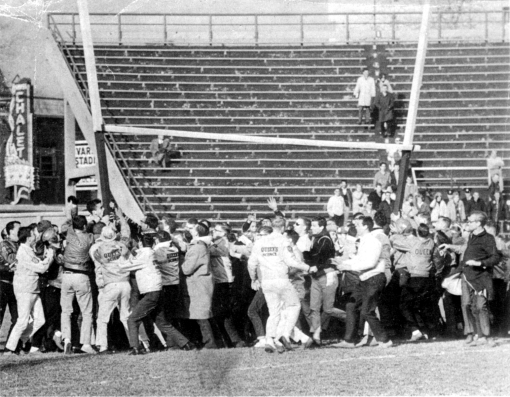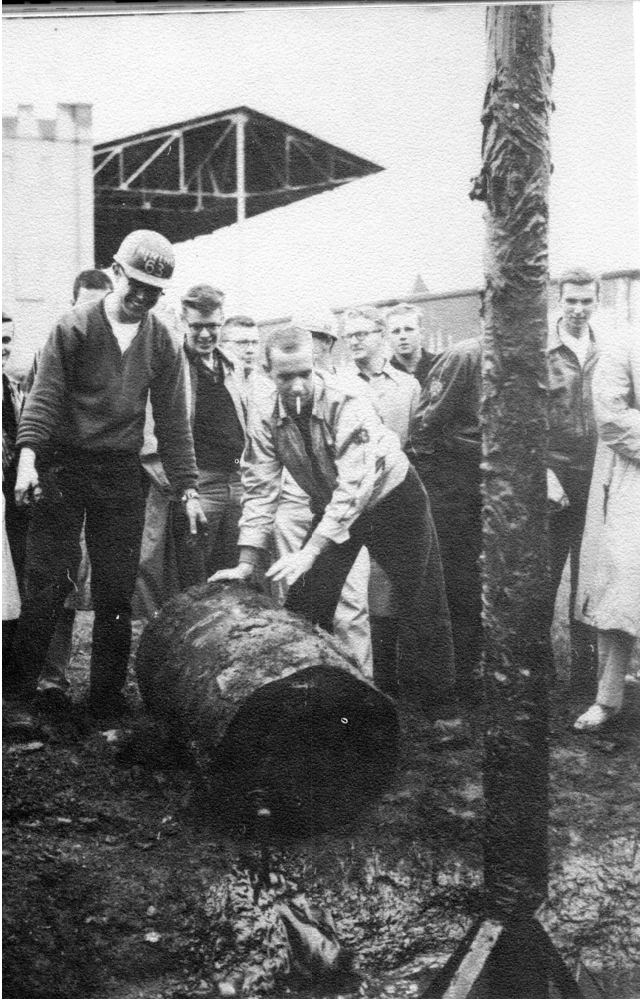|
|
|
|
|
Like most myths, the tale of the Pole's theft has a few
versions. For accuracy, I’ll share the three most popular ones and you can make up
your mind which - if any - you support as an "authentic" description of the
events of October 8th, 1955.
Perhaps these photos from the 1955 yearbook shed some light on the issue. The two poles were shipped back to Kingston via the train. While the popular version claims a route through Winnipeg, for this theft at least, the evidence suggests the poles were put on the "party" train back to Kingston. Train officials were apparently looking for someone to pay the $4.50 shipping charges despite reports of engineers taking up a collection on the train to pay for the shipping of the two goalposts. Internally, Sci ’56 is credited for the theft. The University of Toronto charged Queen’s athletics $350.76 to replace the North-end posts. No matter how it originally fell into our hands, since that time, the Pole has been on permanent loan! See Hiding & Stealing of the Pole for more on our struggle to keep this trophy from U of T and each other. |

|

Being Engineers, they couldn't just sit around and be happy with this trophy – it had to be useful! One can almost imagine a group of Sci. ‘59s sitting around one day and thinking, hey why don’t we get the frosh to climb it! Sounds like a grand idea, a challenge to add to the excitement and fervor of their initiations. But a naked pole is certainly not a challenge worthy enough of inclusion into a well-executed initiation program, so being good engineers, they immediately considered coefficients of friction, temporal convergences and factors of uncertainty.
We all know the results, and in autumn of 1956, Science ’60 became the first year to ascend a greased pole as part of their introduction to Queen’s Engineering. Using axle grease as a suitably messy lubricant, the Frosh were given simple instructions: retrieve a tam off the top of the erected pole. If they did it in less than 2 minutes, the wearing of tams would be discontinued for the year. It took them 8 minutes, 10 seconds and carried on the tradition of wearing tams at all times until December.
From 1957 to 1967, little information has survived in print. Golden Words had not been invented yet and the Journal was the only "consistent" source of info. The Pole was climbed each year, the Pit was eventually added, the tam began to be nailed on the to Pole to make it tougher to remove and the Upper Years began to thrown various objects at the climbing frosh.
Imagine yourself climbing the Pole again (or perhaps for the first time). You want to go for the gold, so you’re up there on the 3rd level. Bit by bit you stretch up, reaching for the elusive tam. With a push you grasp hold of it. Yes, you think, this will be it, the tam is coming off! That is until an unripe apple, rifled in at 30 mph, beans you in the head and you fall 20+ feet onto your classmates below.
Think of a metal pole just under 30 feet tall, well greased with axle grease, and with a tam nailed securely to the top and you have a pretty daunting challenge. Add in projectiles coming in from every direction, disgusting things floating in the mess on which you are standing, and a high potential for bruises, broken boned, cuts and scrapes that don’t heal, and the image becomes more akin to a war rather than a test of teamwork.
In the ‘70s and ‘80s, it was fair game for the watching Upper Years or others in the jeering mob to keep you from the top at all costs. It was part of the challenge and was thought to more closely bond the Science Year together . Tomatoes were the favorite weapons (see image, left, from 1963), perhaps because they would usually only bruise the Frosh. Unlike apples, melons, beer bottles and rocks, which were all heaved into the Pit at hapless, but determined Frosh at some point during those two decades. As well as a good arm, slingshots and a high-powered device called a ‘funnelator’ were used to rifle fruit at the Frosh at high velocity. Not even The Pole Game goes that far! Ask someone who went through Queen’s during that time though and most would say that that’s just the way it was.
Being hit with flying produce was only one of the challenges. The Pole was sunk into a Pit filled with all sorts of vile things mixed in with the mud, water and axle grease. It was so bad that it was deemed too unsafe for women to participate in. That rule was broken in 1976, when 3 female engineering Frosh (called Freshettes) joined the Greasepole unnoticed. Unnoticed that is until the tam was taken off, pictures were taken and it was seen that the second person from the top was a female. As for the Pit, it was not uncommon to find animal parts, horse shit and other unhealthy extras floating around the Frosh's legs.
Regardless of the dangers, Frosh climbed the Pole every year, setting records on both ends. Sci ’77 managed to get through the affair in only 17 minutes whereas it took Sci '72 1204 minutes and two days to retreive their tam!
Once the Pole was a battleground where Frosh fought to gain a foothold, dodge a projectile and generally avoid getting injured, while callous Upper Years and mobs of non-engineers watched, jeered and made every attempt to thwart them. Over time though, bit by bit, the hazing mentality diminished, its rituals no longer appropriate, giving way to a sense of cooperation. The move was a long time coming, perhaps part of a general evolution right from the first Pole climb, but as the 1990s dawned, the Greasepole took its place as a rite of team building... not only for the Frosh, but for all four Engineering years at Queen's.
Many who went through Frosh Week in days gone by would hardly recognize the event. In 1985, after the worst Greasepole ever the year before (see Ascents & Events for more details), throwing projectiles was banned as was the most of the "fun" items in the Pit. Athough students at the time criticised the move, it began a trend to conditions that are now seen as "the way things are done". Then in 1988, lanolin replacedthe traditional axle grease used to lubricate the Pole, and in 1993, it became regulations for all 4 Engineering Years to enter the Pit at some time, marking the final move toward the modern event.
Early on the morning of the Greasepole the FRECs arrive at the secret location of the event, very tired after partying all night. Setting up the site, they remove any hazardous rocks from the site, put up a barricade of snow fencing surrounding the Pit and finally using several gallon drums of lanolin, grease the Pole and set it in place in the Pit. At some point someone notices the sun has come up and sometime later the sound system gets rocking.
Then the Upper Years arrive and chaos reaches the scene. Rowdy, purple, hyper and mostly drunk, the Upper Years work themselves into a frenzy while waiting for the Frosh who are travelling "the long route" to the site in buses that have the heating blasting and windows covered. The FRECs take up position around the snow fence and begin the long process of defending the Pit. It seems every Upper Year think its his or her right to jump into the Pit. Pool noodles, inflatable crocodiles and air horns are common tools.
Finally, the Frosh buses arrive and with a roar from the crowd, the Frosh are welcomed into the cold water of the Pit, suitably shocking after their warm ride. Music blasting the Frosh go at it. Soon they find unlike axle grease, lanolin is very difficult to climb and being lame, they cannot get the tam by themselves. At one hour in, the 4th years are invited into the Pit. With a scream, they enter and after a bit of chaos and fun, begin to help the Frosh, well seasoned at the event. Fifteen minutes later, the 3rd years go in and fifteen minutes after that, the FRECs launch in. The air seems to crackle as new energy is found. The Pit is almost full with bodies, giving adequate mass with which to support the upper levels. Together, all engineers working toward one goal perhaps for the only time in their time at Queen's, the tam is ripped off. Everyone is excited for the Frosh, everyone laughs and yells and chants and moshes. The Frosh started by working together, but only accomplished their task by joining forces with their peers. It is an awesome expereince!
So is the current Pole wimpy, less fun, a waste of time? Certainly not according to the students who participate it. It seems just different, a relection of the different attitudes of the time. There is no doubt that the Pole will change faces again, and there will be those that lament the evolution, but the spirit and the challenge, the only truly important parts, will remain.
As happens with tradition, for every true story, there are dozens of variations, exaggerations and even the occasional fabrication. During the research into the history and spirit of the Greasepole, I came across many stories I could not substantiate or that seemed out of place with the accepted traditions. I leave one for your amusement and critique…
One such story involved the lengths Queen’s Engineers will go to in order to keep their Pole. In 1993, one of the FRECs was quoted in the Journal as attesting that at one point in its history, the Pole was cut into 7 pieces and sent to each continent to prevent it from being reclaimed by U of T.
|